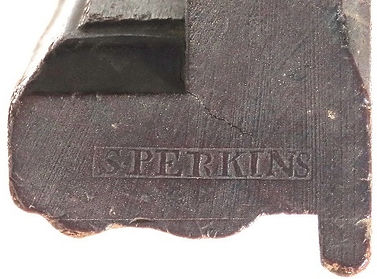
S Perkins
Solomon Perkins (1712-1743)
Bridgewater, MA.
Joiner with working dates 1737-1743.
Research and write-up by Tom Whalen.
S Perkins
Solomon Perkins Moulding Plane
by Tom Whalen
The Solomon Perkins signed plane that I have is one of the most interesting planes in my tool collection. I bought the plane at a Vermont estate auction in my early days of tool collecting, not knowing much about wooden planes at that time. The plane's tall wedge, and the construction of the plane iron intrigued me when I inspected the plane.
Upon sharing my find with other knowledgeable wooden plane collectors I began to understand that the plane was an early example of an 18th century American made wooden plane. How early? Solomon Perkins the owner and probable maker of the plane died in 1743. Perkins’ death would show that the plane was made in the early eighteenth century. Perkins occupation was listed as a joiner, working in Bridgewater from 1737 to 1743.
Solomon Perkins, the first child of Nathan and Martha (Leonard) Perkins was born in Bridgewater Ma. on June 30, 1712. In the spring of 1723 Solomon’s father Nathan died, Solomon was 11 years old, what lies ahead in his future yet unknown. In 1728 Thomas Perkins, the brother of Nathan received guardianship of Solomon and his four siblings for reasons unknown. Thomas would set the path for Solomons’ future. Solomon became an indentured apprentice to Jonathan Sprague (born in Hingham Ma 1686) a journeyman house wright, millwright, and carpenter in Bridgewater.
In a scenario that often took place in Colonial America, a young lad would become indentured to a master journeyman, live in his household, and fall in love with one of the master’s daughters. Were these encounters beneficial to the master, one wonders.
Such was the case with Solomon. Solomon and his master’s daughter Lydia Sprague were married on December 31, 1733, in West Bridgewater Ma., they would have 5 children. Solomon would ply the trade of a joiner in Bridgewater to 1743.
Solomon died on September 29, 1743, at the early age of 31. Solomon’s death took place less than 4 months after the birth of his youngest son Eliab. His unexpected death left his wife Lydia the task of raising a family of five, the oldest being 8 years old twin boys.
A probate search on Solomons’ estate showed no tools listed in the inventory.
The yellow birch complex moulding plane bearing the name of Solomon Perkins appears to be the only known example. The dimensions of the plane and wedge define the plane, making the plane appear to be large in stature. The length of the plane is 10 1/2”, the width is 2 ¼”, the wedge protrudes 3 ¾" above the wedge slot. The plane body has heavy 3/8” flat chamfers that turn out on the heel and toe of the plane. The escapement side of the plane has an ½” reverse ogee profile along the length of the plane turning 90 degrees into the toe and heel. The plane has a fixed fence and cuts an ogee profile 1 ¾” wide.
The hand-forged plane iron is 8” long, is interesting in the way the blacksmith chose to weld the tang and cutting edge together by an early technique of overlapping the tang onto the cutting edge.
The plane is uncleaned with over 275 years of patina intact, is in great condition save for the hanging hole close to the heel.
Seeking more information on the plane I reached out to Michael Humphry. Mike is one of the most knowledgeable people I know on American wooden planes.
Mikes assessment:
“A number of the S Perkins plane’s features imply an early origin, but the most profound is the way that the shoulder mold terminates at each end of the shoulder.
Between approximately 1680 and 1730, a few English platemakers terminated their shoulder molds by returning them into the plane body at 90 Degrees, using the same mold as on the shoulder. The alternatives would have been to simply run the shoulder mold to the ends of the plane, soften the shoulder ends with a gouge cut or a combination of the above. Examples exist by Robert Hemings and Robert Wooding using a cove mold on the shoulder, and there is an example known by John Gilgrest using an ogee mold on the shoulder. No English maker is known to have used that feature regularly. Several unsigned English and American examples are also known to have that feature.
One American platemaker, N Potter, did regularly return his shoulder cove molds to the body at 90 degrees. The presumed maker was born in 1693, but it is not known just when he made his planes. Currently, only one other signed American plane is known which has the coved shoulder return to the body at 90 degrees. Jonathan Tower, the maker, wasn’t born until 1758, but it is believed that he was influenced by N Potter, who lived in the same area.
That shoulder mold return is known to be an early feature, but the existence of the Tower plane demonstrates that the feature cannot be precisely dated.
Your S Perkins plane has an ogee shoulder mold which returns to the body at 90 degrees, just as it does on the John Gilgrest, Robert Wooding, and N. Potter planes.
Your researched dates, Solomon’s location, his profession and the features of the plane all work well together.”





